|
FIELD MARSHAL EARL HAIG
by The Right Honourable The Lord Astor Of Hever PC DL
formerly The Life Guards
|
In the very challenging year of 2020, against a backdrop of a global pandemic and Brexit, an opportunity to reassert the enduring strength of Anglo-French relations presented itself with the restoration of a memorial to my grandfather, Field Marshal Earl Haig, Commander-in-Chief of the British Army on the Western Front from December 1915 until the end of The Great War. He was Gold Stick & Colonel of The Royal Horse Guards (The Blues) from 1919 to his death in 1928.
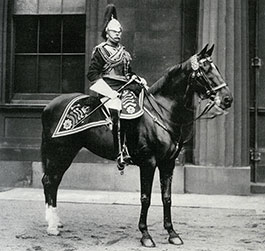 Field Marshal Earl Haig as Gold Stick & Colonel of the Royal Horse Guards (The Blues). Alamy Field Marshal Earl Haig as Gold Stick & Colonel of the Royal Horse Guards (The Blues). Alamy |
A striking equestrian statue dedicated to him in the main square of the northern French town of Montreuil-sur-Mer, which served as the location of the combined British Armies’ GHQ from the Spring of 1916, is now in need of repair. The project has the blessing of the town’s mayor who is keen to highlight the crucial role played by Montreuil in assisting British Forces and their Commander-in-Chief in achieving the final victory.
The little walled town of Montreuil-sur-Mer was close to the front line, but also within easy reach of the Channel ports. Situated on the main London to Paris route and near the huge transit and training camp at Étaples, Montreuil benefitted from strong defences with strict access control, thus reducing the risk of espionage.
Between 1916 and 1918, nearly 2,000 soldiers were working at GHQ within the town’s walls, with a further 3,000 working in other war departments in the town; and it became the military, diplomatic and logistical nerve centre for the largest army Britain had ever mobilised. The population of Montreuil warmly welcomed the ‘Tommies’ as a further demonstration of our two nations’ Entente Cordiale. Sustaining an army of nearly two million men on foreign soil was a colossal commitment, not least in the final weeks of the war when Haig’s divisions were almost constantly on the move.
After the war, both the British and the French erected equestrian statues in memory of the close co-operation between their military leaders and armies.
A year after his death, in 1929, a fine statue of Marshal Foch, the French Supreme Commander, was erected by the British in London’s Victoria Station.
The following year, France returned the compliment, recognising Haig’s decisive and critical support of his French counterpart. Commissioned and funded by the town of Montreuil together with French veterans’ associations, the statue was unveiled in June 1931, with statesmen and military leaders from all over the world attending.
 The statue at the 1931 unveiling The statue at the 1931 unveiling |
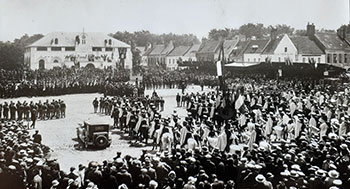 The 1931 unveiling of the statue The 1931 unveiling of the statue |
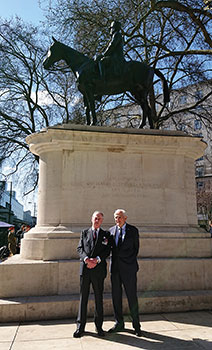 The statue of Marshal Foch by Victoria Station. The author, left, with Foch’s great grandson The statue of Marshal Foch by Victoria Station. The author, left, with Foch’s great grandson |
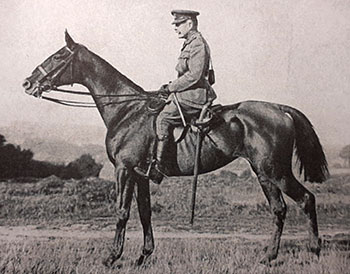 Field Marshal Earl Haig on Poperinghe. IWM Field Marshal Earl Haig on Poperinghe. IWM |
The sculptor was Paul Landowski, who also created the Christ the Redeemer statue on the Corcovado Mountain overlooking Rio de Janeiro, and Marshal Foch’s Memorial Tomb in Les Invalides. Haig is seated on Poperinghe, a stalwart companion on the Field Marshal’s visits to his troops across the battlefields of France and Flanders, and through the London streets for the 1919 Victory Parade. It was also the horse which, at my grandfather’s funeral, followed his coffin with his master’s boots reversed in the stirrups. As the coffin was placed on the train for Haig’s final journey to Edinburgh (and his resting place in the Borders), Poperinghe, normally a very calm horse, became agitated and reared up.
In July 1940, in an act of vengeance, invading German troops destroyed the statue, leaving a solitary plinth. After the war, again through the generosity of local veterans, the statue was recast from Landowski’s original mould, which had been kept under lock and key in Paris throughout the Nazi occupation. Three tons of German bronze were poured into the mould as a reparation levy. The restored statue was unveiled at another grand ceremony in 1950.
Notably, Haig is the only British military leader honoured with an equestrian statue in France. In the last seventy years, time has taken its toll on the bronze and this elegant memorial now needs urgent attention. A restorer has been selected to undertake the work, and all relevant authorisations have been obtained. A Restoration Committee has been established to raise the necessary funds and we are well on our way towards meeting our target. Also on the committee is Dr Charles Goodson-Wickes, formerly Surgeon Lieutenant Colonel, The Life Guards. His great grandfather, Sir Frank Fox, was on the Staff at GHQ and afterwards wrote GHQ (Montreuil-sur-Mer).
The unveiling of the restored statue had been planned for Saturday 19th June 2021, the date of Field Marshal Haig’s birthday, however sadly due to the Covid restrictions, this has been delayed to Saturday 11th September. After the unveiling and wreath-laying at the War Memorial on Saturday, the Mayor of Montreuil will be giving a reception for our guests, as will the Mayor of Le Touquet on Sunday. In addition, donors will be invited to a black-tie and mess kit dinner in the Chateau de Montreuil on Saturday evening.
In Haig’s obituary in the 1928 Summer edition of the Household Brigade Magazine, the Editor wrote, ‘Nothing pleased him more than watching cavalry at work, and I remember so well the almost boyish pleasure and joy that he experienced when he took hold of the Blues in Windsor Park and drilled them. Few honours attracted him as much as the Colonelcy of the Royal Horse Guards’.
Whilst Colonel, in 1924, he unveiled the Household Cavalry Memorial in Zandvoorde, a duty which meant a great deal to him as his brother-in-law, Lord Worsley, Royal Horse Guards, had been killed in action there in October 1914; Worsley’s family paid for the land on which the Memorial stands.
In the famous painting by Sir Alfred Munnings of the 1927 Presentation of Standards, which hangs in the Household Cavalry Regiment’s Officers’ Mess, Haig and King George V take centre stage. Less than a year later, in February 1928, eight stalwart Royal Horse Guards carried my grandfather’s coffin on their shoulders to the gun carriage for its last journey to and from Westminster Abbey. Directly behind the gun carriage marched a further detachment of The Blues; the funeral procession was witnessed by around a million people standing in the cold London streets. One of the pallbearers was Marshal Foch who was overcome with emotion; ‘we saw eye to eye completely’ was all that he could articulate as the tears rolled down his cheeks.
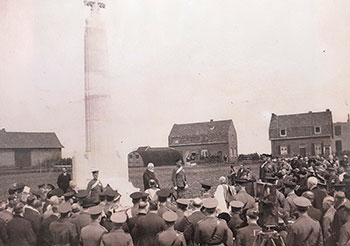 The Household Cavalry Memorial at Zandvoorde. Unveiled on 4th May 1924 by Lord and Lady Haig, the memorial commemorates the soldiers of the 1st and 2nd Life Guards and Royal Horse Guards, killed during the 1st Battle of Ypres, October 1914 The Household Cavalry Memorial at Zandvoorde. Unveiled on 4th May 1924 by Lord and Lady Haig, the memorial commemorates the soldiers of the 1st and 2nd Life Guards and Royal Horse Guards, killed during the 1st Battle of Ypres, October 1914
|
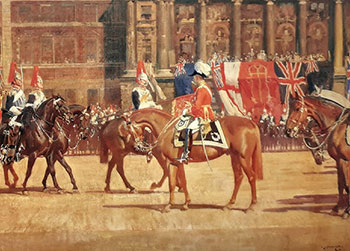
Presentation of Standards, Horse Guards 1927
Sir Alfred Munnings |
The British Ambassador to France has accepted our invitation to attend the unveiling, as has the President of the Royal British Legion, established by my grandfather 100 years ago when he became its first President.
The Silver Stick has also accepted, and The Blues and Royals will be sending two senior non-commissioned officers in mounted review order, and a trumpeter.
The three other regiments of which Haig was Colonel, and his first regiment, will be represented by senior officers along with veterans. In addition to The Blues and Royals, we expect to have Hussars, Lancers, Scottish Borderers, and the London Scottish, all in full dess uniform with bands and pipers. The Mayor has promised to put on a good show and I’m confident that it will be a magnificent occasion. And I hope that many former Household Cavalry officers and veterans will attend.
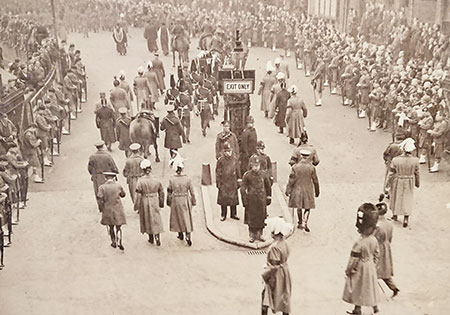 The Blues detachment behind the funeral gun carriage The Blues detachment behind the funeral gun carriage
|
|
|


 The statue at the 1931 unveiling
The statue at the 1931 unveiling The 1931 unveiling of the statue
The 1931 unveiling of the statue The statue of Marshal Foch by Victoria Station. The author, left, with Foch’s great grandson
The statue of Marshal Foch by Victoria Station. The author, left, with Foch’s great grandson Field Marshal Earl Haig on Poperinghe. IWM
Field Marshal Earl Haig on Poperinghe. IWM The Household Cavalry Memorial at Zandvoorde. Unveiled on 4th May 1924 by Lord and Lady Haig, the memorial commemorates the soldiers of the 1st and 2nd Life Guards and Royal Horse Guards, killed during the 1st Battle of Ypres, October 1914
The Household Cavalry Memorial at Zandvoorde. Unveiled on 4th May 1924 by Lord and Lady Haig, the memorial commemorates the soldiers of the 1st and 2nd Life Guards and Royal Horse Guards, killed during the 1st Battle of Ypres, October 1914
 The Blues detachment behind the funeral gun carriage
The Blues detachment behind the funeral gun carriage